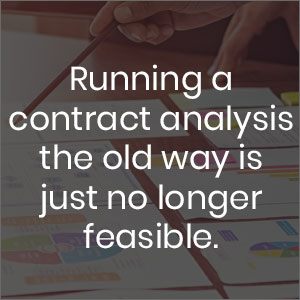Contract analytics is a review of an organization’s agreements to identify and extract pertinent content from contracts. The analysis may extract information about:
- Auto-renewal clause existence
Auto-renewal dates - Contract expiration dates
- Region of contractual governing law

- Indemnities
- Liquidated damages
- Warranties
- Pricing (valuations)
- Payment terms
- Penalties
- Maximum liabilities, and others
This information has always been important to companies and allows them to manage risk. However, with today’s technology, finding and retrieving this information is more readily accessible than it has ever been.
HISTORIC CHALLENGES
Contract analytics has historically been a thorny subject. Many contract managers will attest to the days when the senior executive staff would send a directive. They wanted an analysis of the liability limits across all the company contracts. Or perhaps they might want to understand the financial opportunities across all 7,593 active sales contracts. Running a contract analysis the old way is just no longer feasible.
By the time the busy associate general counsel or contract manager raced through the contract reviews, a week or two or three had passed. In more than one case, the executive asking for this information had moved on to other issues. Countless hours of work, only to find out the information was no longer needed, because it took too long to collect. Argh!
CONTRACT ANALYTICS WITH ARTIFICIAL INTELLIGENCE
Today’s corporations and law firms host countless contracts. Running a contract analysis the old way is just no longer feasible. By the time you review the due diligence put into all the contracts, the data is stale. We are in an era of big data and need technology and business processes to keep up.
Enter contract lifecycle management (CLM) technology. Modern systems are equipped with powerful artificial intelligence engines that make contract analytics a snap. Today’s systems use NLP (natural language processing), to read, understand, and extract vital information from each agreement.
Aside from being able to do this search, find, understand, and extract functions at superhuman speeds, the system will not get tired. An AI engine can run for hours, days, weeks, months, and perhaps even years. It won’t stop until it completes its task. Nor will it get bored with the tedious work. This is true, even when faced with reviewing 40,000 or more contracts!
Additionally, AI can quickly assess risk in contracts (performing the risk analysis much faster than a team of lawyers) by identifying terms and clauses that are suboptimal.
REAL-TIME ANALYSIS
Back to that example of the contract manager working tirelessly on an analysis for the senior executive team. Done manually, once the information was ready, the executive team had already moved on to a new issues and concerns.
In this respect, a huge advantage of an AI-equipped analytics engine (as part of a contract management system), is the real-time or near-real-time results. Given the speed of computing and the AI, thousands of contracts and documents can be scanned in a matter of minutes (hours at most). Of course, this depends on the nature of the search, complexity, quality and volume and length of agreements reviewed. But, in any case, the review phase and analytical summary provided will be significantly faster than a similar review run by people. And it will be much less painful on your staff, too!
ANALYSIS NOT DATA COLLECTION
Truly, a big part of the contract analytics challenge is in data collection. In that regard, it is clear that a computerized system with artificial intelligence will provide faster data collection than humans, across large volumes of contracts. But, the data collection is not the high-value element of the work. For a general counsel or contract manager – value lies in the analysis and interpretation of the results. In fact, getting the CLM to do the hard data collection work, frees up time to do this high-value interpretation and strategic work.
ARE ALL AI’S THE SAME?
It is tempting to think that an AI is an AI. In other words, they are all the same. But, that is simply not true. First, when considering AI technologies for contract analytics – look first to the underlying platform. Current AI technologies may be developed in-house by the vendor. Or they may leverage proven platform technologies like IBM Watson, or Microsoft AI. Forrester even has a scale for vendors implementing AI technology and features. It runs from Pre-Kindergarten through to 11th Grade and above. This is a good characterization of the market – as many vendors developing in-house solutions of their own are shown at the Pre-Kindergarten level. But that’s only the starting point. Doing more for less is about gaining more impact, for less stress!
After determining the underlying technology to help your contract analytics, find out what the different vendors have done to prepare the AI for your contract analytics work.
As an example, ContractPodAi has put extensive work into building out Watson’s AI capabilities. That means taking the time and effort to train the AI with hundreds of thousands of contracts to refine its analytics capabilities. Doing so means you as a customer, don’t have to spend six months or more training your new system to deliver the results you need out of the box.
The power of good contract management with powerful AI-based contract analytics is clear. It helps your company better use the resources at hand and manage risk. When the general counsel’s office is continually pushed to provide ‘more for less’ – this is an important attribute. Contract analytics with a powerful out-of-the-box AI that is ready to go (like the ContractPodAi offering), means you and your team spend time analyzing results, and pulling together projects; rather than merely collecting data.
Remember, doing ‘more for less’, is about gaining ‘More Impact, for Less Stress’!



